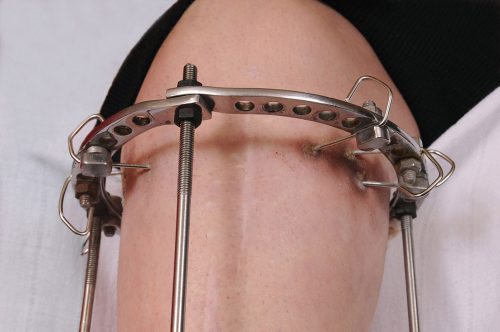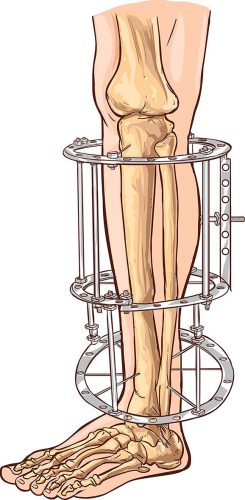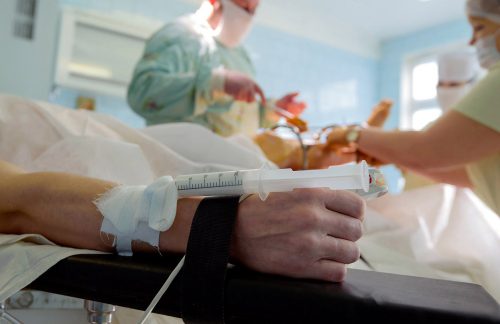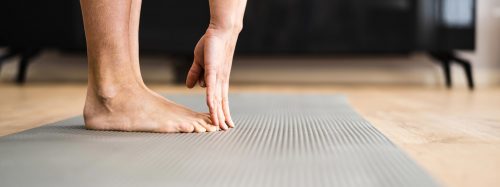
Limb lengthening and reconstruction surgical (LLRS) techniques are those used to replace missing or lost bone, lengthen abnormally short bones, or straighten deformed bones and joints.
These techniques can be applied to both children and adults, and can be used to effectively treat limb length discrepancies, limb deformities, severe injuries, deep infections, and other complex limb conditions. Limb lengthening can also be carried out for aesthetic reasons, such as for patients who desire additional height.
Limb lengthening and reconstruction surgery (LLRS) is possible due to a process called distraction osteogenesis discovered by a Russian surgeon G.A. Ilizarov, which utilises the ability of bone to grow and regenerate over time when placed under a distraction force, using either internal or external fixators to achieve this.
Ring fixators are devices used most commonly to guide the distraction process, during which the existing bone is split (osteotomised) and gradually pulled apart, allowing new bone to grow and fill in the space between the two fragments as they move apart. The entire process is done very gradually, usually at a rate of a millimetre a day, and may take a period of several months, depending on the amount of lengthening needed.
More uncommonly, minor bone deformities can be corrected all at once during surgery, obviating the need for distraction osteogenesis. Whether or not this is possible will depend on the type and severity of the deformity, as well as where it is located.
On the other hand, complex limb length discrepancies and deformities require exacting and precise calculations to be made in order to achieve accurate three-dimensional correction of the deformity. Nowadays, LLRS surgeons regularly use computer-assisted hexapod technology that employ Stewart platform techniques (also used in robotics and NASA flight simulators!) on the ring fixators to achieve reliable and comprehensive correction of complex limb deformities.
Limb lengthening and reconstruction surgery is useful in a number of areas, including:
- Congenital bone deformities, short limbs & dwarfism
- Complex trauma with extensive bone loss and/or skin injury
- Cancer treatment involving bone loss
- Deep infections involving bone and surrounding soft tissue
- Aesthetics: increased height
Some people are born with certain bone deformities due to various developmental issues. One common example of a congenital bone deformity that can be treated with limb lengthening and reconstruction surgical (LLRS) techniques is limb length discrepancy, where one limb is shorter than the other. With distraction osteogenesis techniques, the shorter limb can be lengthened to match the other limb, allowing the patient to walk normally without back, hip and knee pain. Other bone deformities include bent or rotated limbs, often due to birth defects or prior trauma that was not adequately treated. Such deformities, if untreated, can likewise cause problems with walking, and chronic pain in the back, hips, knees and ankles. These deformities can be successfully treated with LLRS techniques.
A common application of limb lengthening and reconstruction surgery lies in trauma surgery. Severe trauma to the limbs can sometimes result in nonunion or malunion of the bone, which is when the bone either does not heal properly or heals in a deformed position. This leads to pain and instability, which can be solved with LLRS techniques to restore lost bone and correct limb malalignment.
In complex trauma involving extensive skin and soft tissue damage (in addition to complex fractures), it is often not possible to perform conventional internal fixation of the fractures due to the high risk of infection and limb loss. In such instances, external ring fixation and treatment with LLRS techniques is an invaluable and often only viable option for successfully saving an otherwise-unsalvageable limb.
The treatment of bone tumours and severe bone infections, even when successful, can result in extensive bone loss, resulting in the need for limb lengthening and reconstruction surgery to replace lost bone and restore normal limb length and alignment.
The procedure is also increasingly being used for cosmetic purposes, in order to increase stature. Limb lengthening and reconstruction surgery can safely add up to 4-5 inches in height in healthy patients.

Limb lengthening and reconstruction surgery (LLRS) should be considered for most patients with significant limb length discrepancies (more than 2cm discrepancy), severe bone deformities (bent or rotated bones and joints), and those who have suffered significant bone loss (e.g. from severe trauma, bone infections or bone tumours). Such deformities would severely affect ambulation, limb function and daily activities, and predispose to chronic pain in the back, hips, knees, ankles and feet if left untreated.
Limb lengthening and reconstruction surgery (LLRS) may not be suitable for some people of advanced age, although this would depend on their general health, bone density, and the ability of their bones to regenerate. You can consult your LLRS-trained orthopaedic surgeon to determine if you are suited to limb lengthening and deformity correction surgery.

Limb lengthening and reconstruction surgery (LLRS) can be performed as a minimally invasive procedure that will require a hospital stay of several days (for more complex deformities, the hospital stay may be longer, and you will be advised by your surgeon accordingly). You will be put under general anaesthesia and a small incision (usually 3-5cm) will be made so that your doctor can gain access to the part of the bone that needs to be cut (osteotomy). You will then be fitted with either an external or internal device that will guide the lengthening or reconstruction process.
The distraction process can be started about a week after the LLRS procedure. You will begin to adjust the external or internal device you were fitted with during surgery, distracting the bone at a rate of approximately 1mm per day to allow new bone to form in between. X-rays will be performed regularly throughout this “distraction phase” to ensure that the bone is regenerating as expected.
Once the limbs have reached the desired length, position and alignment, you no longer need to adjust your device. However, it will have to remain in place throughout this recovery period until the bone is fully healed, as newly formed bone is weak and prone to breaking without the support of the device. This part of the recovery period is known as the “consolidation phase”, and the duration is typically twice that of the “distraction phase”. Again, X-rays will be obtained intermittently to check on the healing process.
When it is time for the external or internal device to be removed, which will depend on the rate of healing, you will need to return to the hospital for a short surgery. The removal will be carried out under general anaesthesia and is generally a quick and simple procedure. After the fixation device is removed, you may require the use of a cast for about a month in order to protect the limb before the cast can be removed in the clinic.
The recovery period also involves intensive physiotherapy, which is necessary to ensure restoration of limb strength, stability and movement after the procedure. Physiotherapy is essential for optimal recovery of limb function and walking ability.
Without complications, it will usually take 4 to 6 months (sometimes longer in complex deformities) to recover from limb lengthening or limb deformity correction surgery. This is dependent on the duration of the distraction phase, your bone’s natural ability to grow, and your commitment to rehabilitating your limbs during the recovery period.
During the distraction phase, you will be able to put full weight on the affected limb if an external ring fixator has been used (weightbearing is often protected if an internal device is used and you may have to use crutches). You can begin to return to most of your regular daily activities after the consolidation phase, when the regenerate bone has healed. It is important to stay active and follow the prescribed physiotherapy to recover fully.

Limb lengthening and reconstruction surgery is a safe procedure overall. Potential complications associated with limb lengthening or reconstruction can be put into two categories:
- Bone complications
- Soft tissue complications
Bone complications include issues like delayed union or nonunion (the bone does not regenerate or heal adequately), and premature consolidation (which is when the bone heals too quickly before adequate deformity correction can be achieved). These obstacles may require additional surgeries for correction.
Soft tissue complications include muscle weakness or nerve injuries, which can usually be avoided by careful pre-operative planning and gradual deformity correction. Minor pin and wire site infections are common when using an external ring fixator, and this is usually easily treated with a short course of oral antibiotics, or by removal of the affected wire or pin in the clinic if the infection persists.
Under MOH guidelines, limb lengthening and reconstruction surgery for limb length discrepancy, limb deformities and significant bone loss (e.g. trauma, infection, tumours) is generally MediSave claimable. The exception lies in elective surgeries for purely aesthetic reasons, as MediSave does not cover cosmetic procedures.

Limb lengthening and deformity correction using advanced computer-assisted hexapod LLRS techniques can be highly beneficial for anyone whose limb function and quality of life has been affected by significant limb deformities or severe bone diseases. It is also important to understand that LLRS surgery, with its unparalleled ability to correct complex limb deformity, is associated with some potential complications (typically minor) and involves a significant recovery period.
If you are considering limb lengthening or deformity correction surgery for cosmetic purposes, it is important to keep in mind that the recovery period is long, and ensure that you are prepared to fully commit to the recovery process.
Whatever your reason for undergoing this procedure, please speak to a trained Limb Lengthening and Reconstruction Surgeon who will be able to thoroughly explain the best procedure for you, what it will involve, and what you can do to ensure that your recovery goes smoothly.

